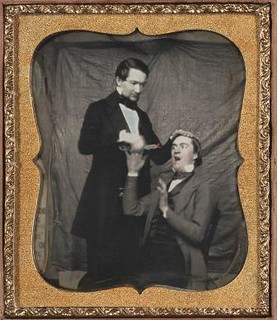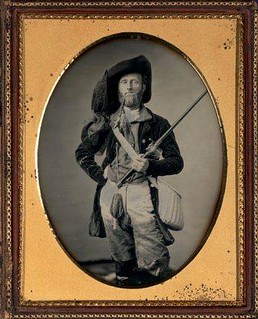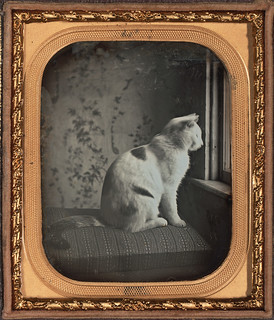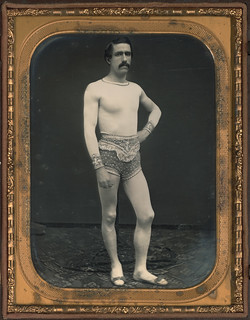 |
| A daguerreotype of men sharing daguerreotypes, 1850. Courtesy of Taft Museum of Art |
 |
| Comic Dentist, about 1850 Courtesy of Taft Museum of Art |
The earliest form of a photograph, a daguerreotype is a singular, unique image that is crafted onto a silvered copper plate. Each picture is a one-of-a-kind, with no negatives from which duplicates can be made. The earliest daguerreotypes required exposures of up to thirty minutes, but within a few years could be made in 10 - 20 seconds.
To create an image, the daguerreotypist coated a metal plate with silver and applied iodine vapors to make it sensitive to light. After placing the plate inside the camera, he removed the lens cap to expose the plate, capturing an image of the subject. Afterwards, mercury vapors were applied to develop the image, then mounted behind glass in an airtight case to protect the delicate surface.
 |
The Fisherman
William C. North (American, 1814–1890)Courtesy of Taft Museum of Art |
 |
| Clown, about 1850–55 Courtesy of Taft Museum of Art |
The collection features more than just portraits: landscapes, pets, leisure activities, entertainers, trade workers, slavery, and post-mortem memorials were all part of the imagery of the Victorian Era. While some daguerreotypes came in 6-inch or 9-inch sets, most are quarter-plate sized, which could easily slip into a pocket.
Occupational portraits, such as the ones above, were based on an understanding that the self was more than just appearance. What one did was central to who one was, a representation of economic security and social respectability. These pictures suggest that identity was less a matter of looks and more about knowledge and ability.
 |
| The earliest Instagram of a cat. Courtesy of Taft Museum of Art |
 |
| Man with Elephant
Thomas Easterly (American, 1809–1882)Courtesy of Taft Museum of Art
|
 |
| One of my favorite portraits, this performer's shorts have small, diamond detailing etched to show the sequins on his outfit. Tightrope Walker, 1855 Courtesy of Taft Museum of Art |
The most spectacular daguerreotypes tell stories of camaraderie, games and amusements, pets and companionship. Both spontaneous and personal, the images on display give viewers a mirrored glimpse into life in the 19th Century.
Explore nine elaborate sections of this "wonderful wonder of wonders," as one man in 1839 called it, through August 25, 2013. Be sure to pick up a booklet when entering the exhibit which tells the stories about each individual shown in the daguerreotypes.
